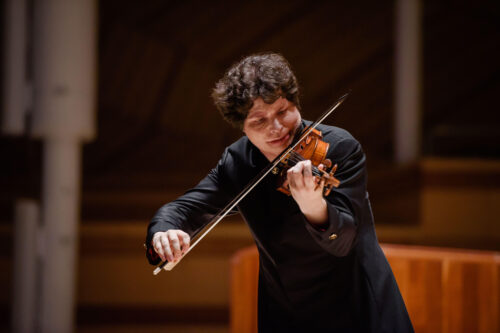
 United States Aspen Music Festival [13]: Benedict Music Tent, Aspen, Colorado, 17-19.8.2021. (HS)
United States Aspen Music Festival [13]: Benedict Music Tent, Aspen, Colorado, 17-19.8.2021. (HS)

Program 33: Zukerman Trio (Pinchas Zukerman [violin], Amanda Forsyth [cello], Shai Wosner [piano]), 17.8.2021.
Beethoven – Violin Sonata No.1 in D major Op.12 No.1; Cello Sonata in G minor Op.5 No.2; Variations on Wensel Muller’s ‘Ich bin der Schneider Kakadu’ in G major Op.121a
Program 34: Augustin Hadelich (violin), 18.8.2021.
J. S. Bach – Sonata No.1 for Unaccompanied Violin in G minor BWV1001; Partita No.2 for Unaccompanied Violin in D minor BWV1004
Perkinson – ‘Blue/s Forms’; ‘Louisiana Blues Strut: A Cakewalk’
Paganini – Caprice No.9 in E major: Allegretto from 24 Caprices Op.1
Program 35: Jeremy Denk (piano), 19.8.2021.
J. S. Bach – Partita No.5 for Keyboard in G major BWV89
Coleridge-Taylor – ‘They Will Not Lend Me a Child’ from 24 Negro Melodies Op.58
Wiggins – ‘The Battle of Manassas’
Chauvin & Joplin – ‘Heliotrope Bouquet’
Rzewski – ‘Winnsboro Cotton Mill Blues’ from North American Ballads
Beethoven – Piano Sonata No.32 in C minor Op.111
Sometimes a musician, the music and the miracles created leave a listener marveling slack-jawed. Augustin Hadelich made that happen Wednesday evening in the Benedict Music Tent, and all a rapt audience could do was gape in wonder at the elegance and depth of what one was hearing.
The recital of unaccompanied violin music began and ended with J. S. Bach, played with an angelic touch and consummate musicianship. Hadelich’s ability to bring out the music within the music created a performance that made this listener believe that Bach really was channeling the glory of God.
Even a thunderstorm that rolled through the Roaring Fork Valley had the courtesy to focus its interruption on the shorter works sandwiched between Bach’s Sonata in G minor, which started the evening, and the Partita in D minor that closed the program. The storm had the good sense to move on before we got to the Partita’s majestic Chaconne, considered the ultimate violin piece ever composed.
Hadelich’s unhurried approach to the sonata turned the Adagio into a meditation on how to make his Guarnieri del Jésu instrument sing as if a human being lived inside it. The melodic line moved gently against Bach’s ingenious writing, making it seem as if we were hearing two or three instruments at once. Hadelich never lost the pulse, and the Fuga that followed wove the various lines together into race-car-like sleekness. But the miracle of miracles was the Siciliana: graceful, moving like waves lapping on a lakeshore. The Presto finale took off like a shot but somehow felt as if it was totally under control.
The Partita’s dance-derived movements each flowed with a natural pulse at a pace that allowed embellishments to feel improvised and kept things moving without haste. The Gigue was especially charming, leading as it does into the monumental Chaconne. At 10 minutes plus it is the longest single movement in any of Bach’s unaccompanied violin works, and it seems to explore everything a great violin can do, all packaged into music that ebbs and flows from quiet contemplation to thrilling climaxes without losing the consistent pulse. Taking this ride with Hadelich was like touring the Grand Canyon in a glider. All you could do was marvel at the beauty.
Between the big Bach works, Hadelich threw in a few changeups. He surrounded a sprightly-played Paganini caprice with two engaging works by Coleridge-Taylor Perkinson. Hadelich mastered the twin challenges in the African-American composer’s ‘Blue/s Forms’, as technically demanding as Bach with the added difficulty of making them swing.
In May I heard Hadelich play Coleridge-Taylor Perkinson’s utterly captivating ‘Louisiana Blues Strut: A Cakewalk’ as an encore to an epic performance of the Brahms Violin Concerto at the San Francisco Symphony’s first full-scale live concert since the pandemic. If anything, he played it even better in this recital. If he ever wants to dabble in jazz, Hadelich could give Regina Carter a run for her money.
As an encore, the Andante from Bach’s unaccompanied A minor Sonata sent us into the chilly night warmed to the bone.
On the surface, Jeremy Denk’s piano recital Thursday followed some of the same ideas, mixing Bach with music produced or inspired by Black culture. Maybe that’s why a passing shower provided only light percussive background to the only Beethoven piece on the program, which followed.
Denk is a great ideas guy. He can express his thoughts cogently and entertainingly with words, and that helps make his playing persuasive, even if his technique at the keyboard can fall short of virtuosity. He also has some visual quirks that endear him to audiences. I lost count of how many times in Bach’s Partita No.5 he tossed his head or swiveled it toward the audience as if to see if they got the joke in this light-hearted piece.
He then made four disparate works into an unusual suite (for a classical recital) that distilled just what makes a Denk concert so compelling.
He told the audience that ‘They Will Not Lend Me a Child’ from Samuel Coleridge-Taylor’s 1905 24 Negro Melodies was typical of a dated compulsion to fit music from other cultures into classical forms. He followed that with ‘The Battle of Manassas’ by the piano prodigy Blind Tom Wiggins, an ex-slave who won over white audiences in late nineteenth-century America with this almost Charles Ives-like mashup of Civil War songs. ‘Heliotrope Bouquet’, the gently evocative ragtime classic by Louis Chauvin and Scott Joplin, brought sheer beauty to the mix, and the finale, ‘Winnsboro Cotton Mill Blues’ from Frederic Rzewski’s North American Ballads, introduced some social justice.
After a somewhat rocky start to Beethoven’s last sonata (No.32 in C minor), Denk found his footing in the second half, the composer’s hymn to glorious C-major harmony and rhythm. Even the passing rain shower faded away by the final notes.
Tuesday’s all-Beethoven recital by the Zukerman Trio also included something quirky. Beethoven probably dashed off his Variations on Wensel Muller’s ‘Ich bin der Schneider Kakadu’ in 1803, when the tune was a success in Vienna, but it wasn’t published until 13 years later. It does not rank among his biggest hits, but it was fun to hear after two serious sonatas.
Pinchas Zukerman’s carefully shaped violin playing plus ardent work from his wife, cellist Amanda Forsyth, benefited the proceedings, but the revelation was pianist Shai Wosner. Playing with fluidity, he paid particularly careful attention to the shadings the other musicians applied to their lines. Everything he played fit beautifully with their work.
The solo pieces, both early Beethoven, managed to capture that extra edge the composer was already adding to the basic Mozart-like approach many musicians take. Zukerman pushed dynamics and expanded on phrasing in the Violin Sonata without taking it too far, and Wosner was right there with him. In the Cello Sonata, Forsyth channeled her ability to coax plenty of drama out of her cello into emphasizing the cello’s commentary in the piano’s grand opening Adagio and the rhythmic interplay in the extended Rondo.
After a slow, straight-faced prelude, in the same vein as the Adagio introduction to the cello sonata and which Beethoven probably added for publication, the trio made a quick right turn into a jolly romp that gave each of the members a moment in the sun. It is not the greatest set of variations by this composer, but it’s still Beethoven, and it brought the recital to a happy close.
Harvey Steiman
